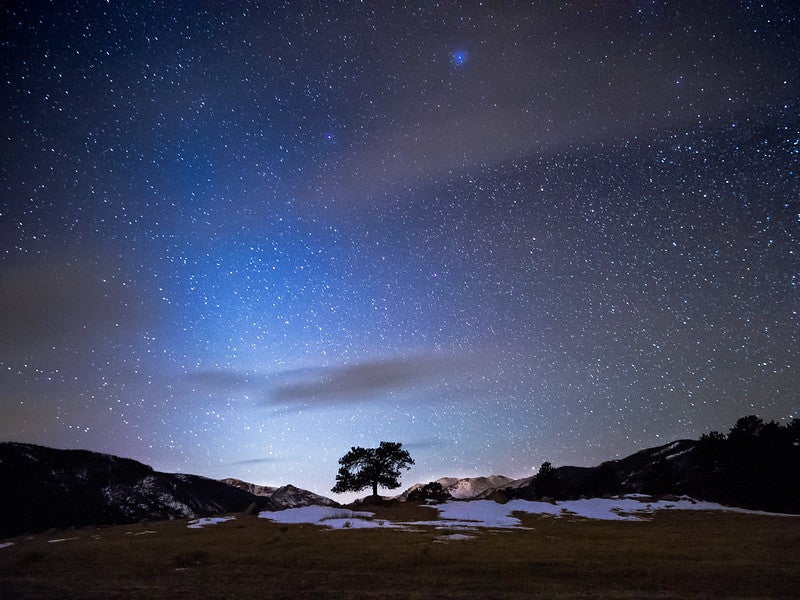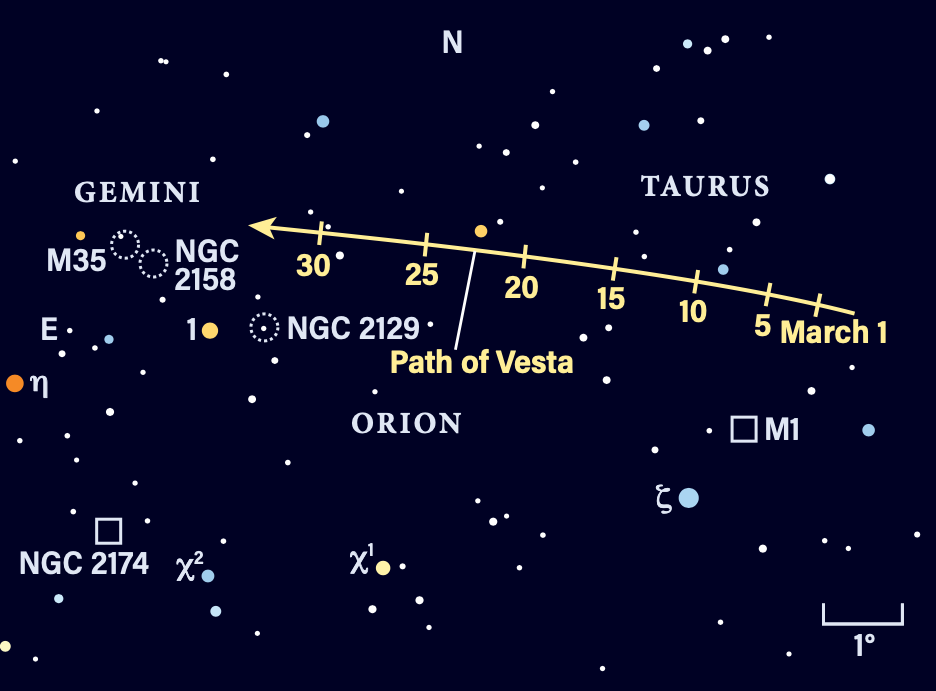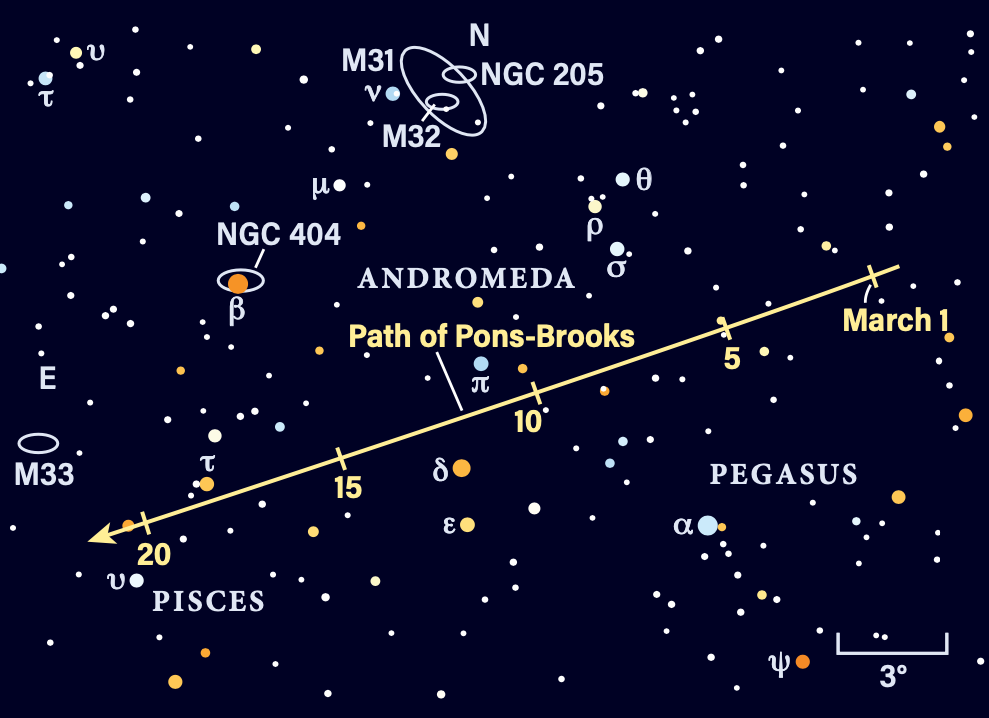
Friday, March 1
With the Moon now well past Full and rising later each day, it’s a great time to catch the zodiacal light, which glows in the sky after sunset in the springtime. The zodiacal light is best seen from a dark location with no city lights. If you can get to an observing location with a higher altitude than the surrounding area, all the better.
Turn to the western sky after the Sun sets. After it grows dark, a dim cone of light will appear above the horizon, stretching upward through Pisces, Aries, and Taurus, possibly even engulfing the Pleiades if your sky is dark and clear. Called the zodiacal light because it follows the plane of the ecliptic through the constellations of the zodiac, this glow is generated by sunlight glinting off the dust left behind by countless comets passing through the inner solar system. It can be very subtle, so give your eyes time to adjust to the darkness and try using averted vision to glimpse it out of the corner of your eye, where the light-sensitive cells are located.
The zodiacal light also makes a stunning subject for nightscape photos, as it is well captured through long exposures.
Sunrise: 6:32 A.M.
Sunset: 5:53 P.M.
Moonrise: —
Moonset: 9:08 A.M.
Moon Phase: Waning gibbous (69%)
*Times for sunrise, sunset, moonrise, and moonset are given in local time from 40° N 90° W. The Moon’s illumination is given at 12 P.M. local time from the same location.
Saturday, March 2
An hour after sunset, Jupiter and Uranus stand about 45° high in the western sky, slowly sinking toward the horizon. The pair set roughly an hour before midnight, affording evening observers a good chance to enjoy them hanging together in Aries the Ram.
Jupiter is easy to find, blazing at magnitude –2.2 — the brightest object in this region of the sky. Tonight it sits 8° below (southwest of) Uranus. The ice giant is magnitude 5.8, rendering it difficult to see with the naked eye under all but the darkest conditions. However, binoculars or any telescope will easily pick up the distant world, which lies about 0.5° south of a 6th-magnitude field star. Uranus spans 4″ and will appear as a dim, gray, “flat” star.
Through your optics, Jupiter is flanked by all four Galilean moons. Io sits alone to the planet’s west, with Ganymede, Callisto, and Europa to the east. Ganymede is farthest out, with Callisto closest and Europa between them early in the evening. Around 10:30 P.M. CST, shortly before the planet sets in the Midwest, Callisto passes due north of Europa. After that, observers farther west will see Callisto continue east as Europa moves west, with the latter now closest to the planet on the eastern side.
Over the course of the month, Jupiter and Uranus will draw closer, ending March about 3° apart.
Sunrise: 6:31 A.M.
Sunset: 5:54 P.M.
Moonrise: 12:11 A.M.
Moonset: 9:40 A.M.
Moon Phase: Waning gibbous (59%)
Sunday, March 3
The Moon passes 0.3° north of Antares at 4 A.M. EST, as the two sit about 10° above the southeastern horizon. It’s a lovely — and easy — pairing to spot, requiring no optical aid to enjoy. Even with the naked eye, you’ll likely notice Antares’ deep red hue. This star’s name translates roughly to either “like Mars” or “rival of Mars,” as it can easily be confused for the Red Planet in the sky. Antares is a red giant star in the later stages of its life. It shines tens of thousands of times brighter than the Sun, though at a cooler temperature. This star marks the heart of Scorpius the Scorpion and, because of its location close to the ecliptic, is often passed and sometimes even obscured by the Moon as it moves in the sky.
There are several globular clusters in this region of the sky as well; if you pull out binoculars or a telescope for a closer look, you may spot several spherical clumps of stars, particularly to the north, west, and south of Antares’ location.
A few hours later, Last Quarter Moon occurs at 10:23 A.M. EST. Additionally, asteroid 3 Juno reaches opposition at 1 P.M. EST. It is visible all night long (from sunset to sunrise) in the constellation Leo the Lion.
Sunrise: 6:29 A.M.
Sunset: 5:55 P.M.
Moonrise: 1:18 A.M.
Moonset: 10:19 A.M.
Moon Phase: Waning crescent (49%)
Monday, March 4
Within the constellation Corona Borealis lies an unassuming 10th-magnitude star: T Coronae Borealis. But T CrB hides an explosive secret: It is a recurring nova, a type of binary system containing a red giant star and a white dwarf. Over time, the white dwarf pulls matter from its companion and, every 80 years or so, there’s enough material to ignite an explosion on the white dwarf, rocketing the system to magnitude 2 — roughly the brightness of Polaris and easily visible with the naked eye — for a week or so.
The last time this occurred was in 1946, and astronomers are predicting it may happen again this year. To prepare, let’s find T CrB in the sky, currently rising around 9:30 P.M. local time and setting around noon. This means both late-night and early-morning observers can catch it.
Corona Borealis is a curved constellation that lies just west of Hercules. Alphecca (magnitude 2.2) is the Northern Crown’s brightest star, also called Alpha (α) CrB. From here, start moving east, following the curve of the crown to magnitude 3.8 Gamma (γ) CrB and then magnitude 4.6 Delta (δ) CrB. T CrB is just 2.2° east of Delta, following the same curve of stars. For now, you’ll need binoculars or a telescope to spot it, but soon we just may see it flare to naked-eye brightness for a brief time before fading away again for another 80 years.
Sunrise: 6:28 A.M.
Sunset: 5:56 P.M.
Moonrise: 2:24 A.M.
Moonset: 11:09 A.M.
Moon Phase: Waning crescent (38%)

Tuesday, March 5
Asteroid 4 Vesta is an easy find right now even from the suburbs, as long as you’ve got good binoculars or a small scope. The main-belt world is currently skirting the skies of Taurus and sliding north of M1, the famous Crab Nebula.
Start your search shortly after dark, with Taurus still high in the southwest, to the upper right of Orion the Hunter and his easy-to-recognize three-star belt. Move on to Aldebaran, the reddish eye of the Bull, also cataloged as Alpha Tauri. From Aldebaran, look about 15.3° northeast for 3rd-magnitude Alheka, the tip of one of Taurus’ two horns.
Eighth-magnitude Vesta sits just under 3° north-northwest of Alheka tonight. M1, which glows at roughly the same magnitude, is less than 2° south of Vesta and about 1° northwest of Alheka. M1 spans about 6′ and is the leftover tangled “mess” following a massive star’s explosive death. That supernova was spotted from Earth about 1,000 years ago, and today we see the wreckage it left behind. The Crab Nebula remains one of the most famous deep-sky objects and is a favorite of astroimagers.
If you sweep your optics around the area, you might also run into NGC 1758, an open cluster that tonight lies some 6.5° west of Vesta.
Sunrise: 6:26 A.M.
Sunset: 5:57 P.M.
Moonrise: 3:26 A.M.
Moonset: 12:11 P.M.
Moon Phase: Waning crescent (28%)

Wednesday, March 6
Comet 12P/Pons-Brooks is quickly approaching perihelion in a month and a half — the closest point in its orbit to the Sun. Eager eclipse-watchers are hoping the comet may even be visible in the sky with binoculars (or perhaps the naked eye!) during the total solar eclipse on April 8.
Now glowing around 6th to 7th magnitude, Pons-Brooks is visible in the west after dark, sinking toward the horizon in the constellation Andromeda. The comet is near the mighty Andromeda Galaxy (M31), a favorite of Northern Hemisphere skywatchers. Under clear, dark skies, you can spot this galaxy with the naked eye, just under 8° northwest of magnitude 2.1 Mirach (Beta [β] Andromedae). Through a telescope or binoculars, you’ll likely also capture Andromeda’s two brightest satellite galaxies, M32 and NGC 205 (sometimes listed as M110).
This evening, Pons-Brooks is about 9.7° southwest of M31. Check out the chart above and you’ll see that the comet is moving southeast through this region of the sky and will slip due south of the galaxy on the 11th.
Sunrise: 6:25 A.M.
Sunset: 5:58 P.M.
Moonrise: 4:19 A.M.
Moonset: 1:23 P.M.
Moon Phase: Waning crescent (19%)
Thursday, March 7
The Moon passes 4° south of Mars at midnight EST. About 50 minutes before sunrise, the two are just visible above the horizon, some 3° high in the southeast. The Moon is now a delicate 12-percent-lit crescent, with only its western limb still in daylight as it quickly wanes toward New. Luna sits to the far right of Mars, itself magnitude 1.2 and visible in the growing twilight through binoculars or a small scope.
Mars is just 0.2° from magnitude 4.3 Iota (ι) Capricorni, appearing almost directly above this star (northwest) in the sky. They’ll be visible in the same field of view through your optics. The Red Planet spans about 4″ — roughly the apparent size of Uranus, which we viewed earlier in the week — and is 97 percent lit. As you follow the planet in the brightening sky, make sure to put away any binoculars or telescopes at least several minutes before sunrise from your location, which may differ slightly from the time given below.
Tomorrow the Moon will pass near Venus and we’ll try to spot these two just before dawn. That will be a more challenging observation!
Sunrise: 6:23 A.M.
Sunset: 5:59 P.M.
Moonrise: 5:04 A.M.
Moonset: 2:42 P.M.
Moon Phase: Waning crescent (10%)
Friday, March 8
The Moon passes 3° south of Venus at noon EST, with the pair visible about 30 minutes before sunrise in the eastern sky.
This time, the Moon is a challenge, close to the horizon and just 5 percent lit. The thin crescent will likely be best visible through binoculars or a telescope, though you may also notice some earthshine on the darkened portion of Luna’s face. This effect occurs when sunlight bounces off Earth to illuminate the regions or the lunar surface now in shadow.
Venus lies to the Moon’s upper left, readily visible as a morning star at magnitude –3.9. It’s clearly visible even against the bright twilight, no optical aid needed. If you do swing your telescope over to the planet, you’ll note that its 11″-wide disk appears 93 percent lit, showing off its noticeable gibbous phase.
Keen-eyed observers may still see a few bright stars in the sky above the Moon-planet pair, such as Altair, Deneb, and Vega, though these luminaries will fade quickly. Once again, make sure you put away your optics prior to the time of sunrise from your location to avoid risking permanent damage to your eyes.
Sunrise: 6:21 A.M.
Sunset: 6:00 P.M.
Moonrise: 5:40 A.M.
Moonset: 4:03 P.M.
Moon Phase: Waning crescent (4%)

Sky This Week is brought to you in part by Celestron.









